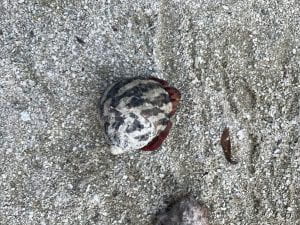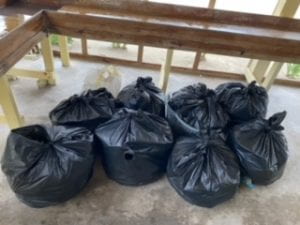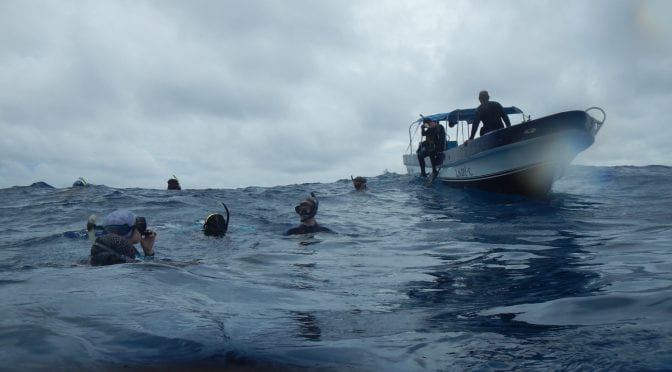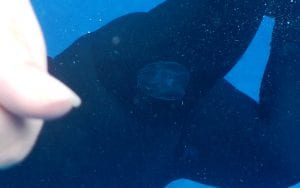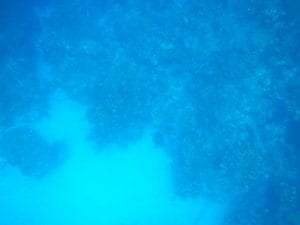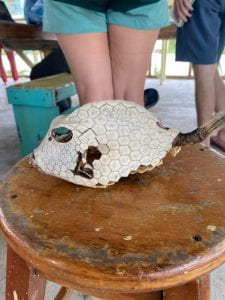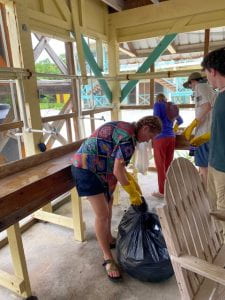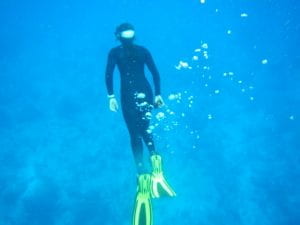Hi all, it’s Faith with Day 6 updates from the 2022 Belize trip!!!
We woke up to gloomy, grey skies with fierce winds, but that did not stop us from conquering the fore reef! Diving the fore reef was incredibly unique, it was unlike any of the shallow patch reefs we usually see. The water was a dark, royal blue, similar to the color of pen ink, and the waves were intense. Usually, the reefs are only a few feet below us, but the fore reef was around 40-50 ft below. Because of the depth, there was no color discrimination unless you swam really close to the reef. I saw lots of new sponge types, but the most interesting was the Giant Barrel Sponge. I saw it close to the “deep drop” towards the edge of the reef; it was on the much deeper side. Because the reef was so far below us, I didn’t see any echinoderms; however, I saw a sea turtle! It was too far away to identify, but from the shape of its bill and fins, I believe it was a loggerhead sea turtle (Caretta caretta). It lacked the hawksbill pattern. The turtle was chilling under/ next to some coral, and it didn’t move even as we all approached it. I assume he was in the area because of the jellyfish swarm above us. Because the waves were so rough, we only stayed out four 20 minutes, and we swam through the jellyfish on our way back to the boat.
When we got back to glovers, I got to see some brown anoles (A. sangrei) because Dr. Correa’s son was catching them and letting us hold them. You can tell they are brown anoles because they are brown and have bright orange dewlaps (throat fans) that lack dots. I don’t know where he was catching them, but I assume they were crawling around the station.
After our much needed break, we made a research question to answer. We asked “How much of the trash that washes up on Glover’s reef can be disposed of on island, where is it located, and which area is the most efficient to clean?”
Our “trash” hypothesis was that the most debris would be located at the coral graveyard and that 50% would need to be taken off-island to dispose of. Our hypothesis really was trash because WE WERE COMPLETELY INCORRECT!!! After garbage collection and sorting, we found that 88% of trash could be disposed of on-island via burning, and we found that the mangroves behind the kitchen collect the most garbage by mass. Therefore, if we are going to do more beach cleanups at glovers, we should have volunteers focus on the areas near those mangroves.
While we were collecting the trash, Nate made an interesting find– an almost intact cow fish skeleton?! I got to carry it back because everyone else thought it was gross. I mean, it is, but that wasn’t going to stop me! (Pictured below)
After listening to talks of Annelids, hydroids, ocean debris, and anemones, our group got to watch a hermit crab change shells! (Nate also found the shell while gathering trash, and he kindly gave it to the hermit crab). We all got very emotional, and it was the perfect way to end this reef day.
Till Tomorrow! P.s. I’m not sure why this blog didn’t get published on the day I wrote it, but it’s up now that we have better wifi, sorry!!!
QOTD: “I can’t explain it but our group gets really emotional over hermit crabs”
“Ugh, I lost my brainblast”

